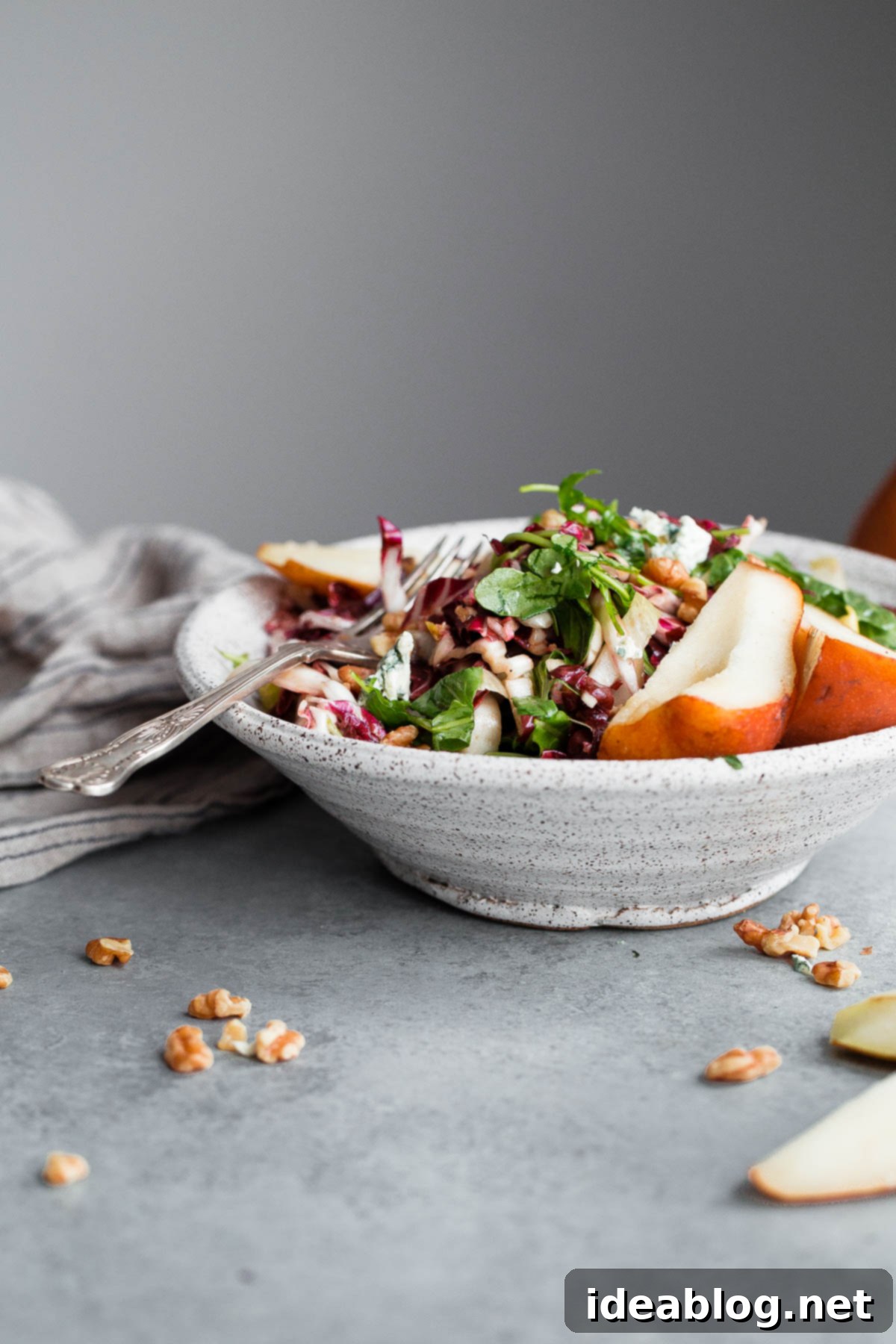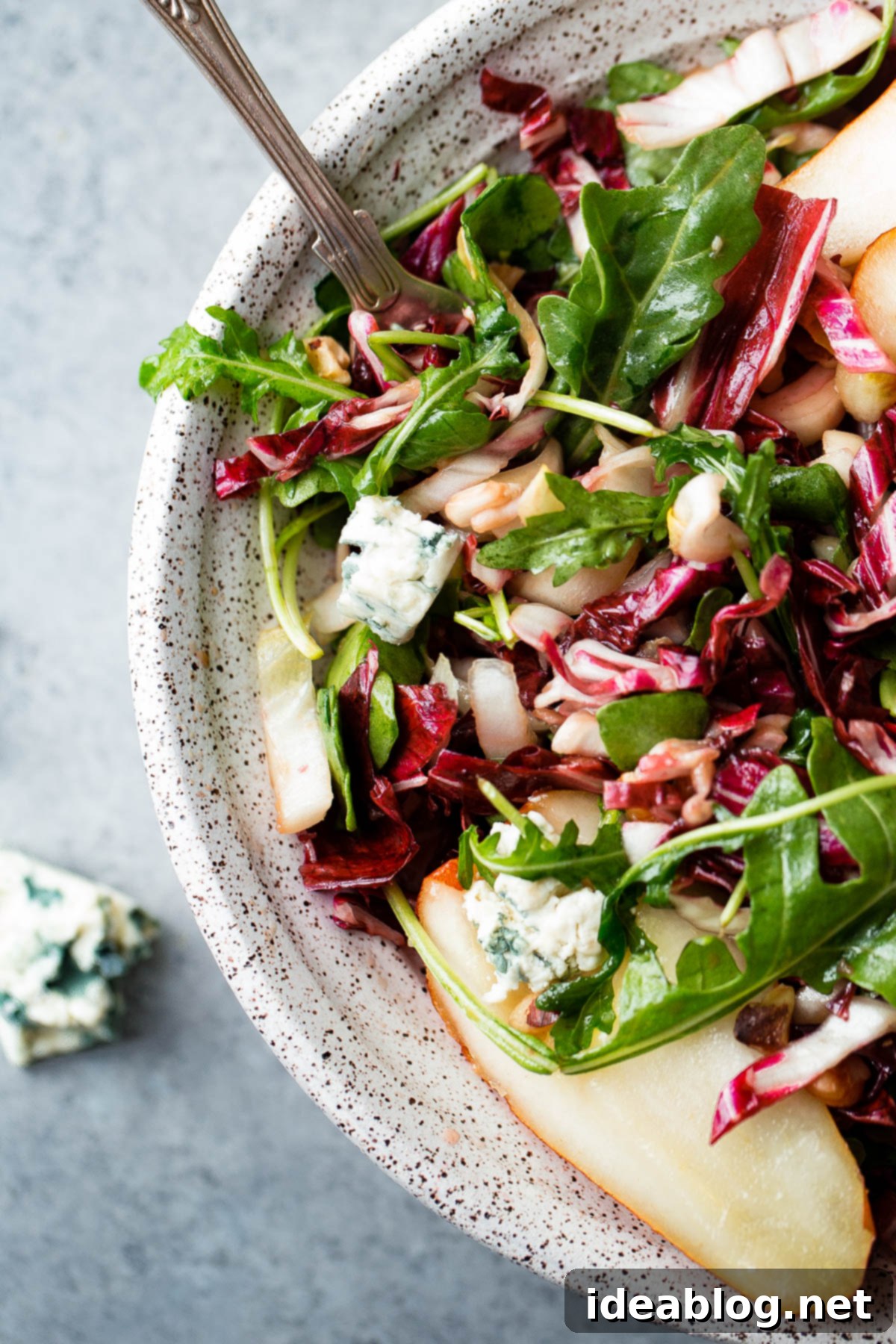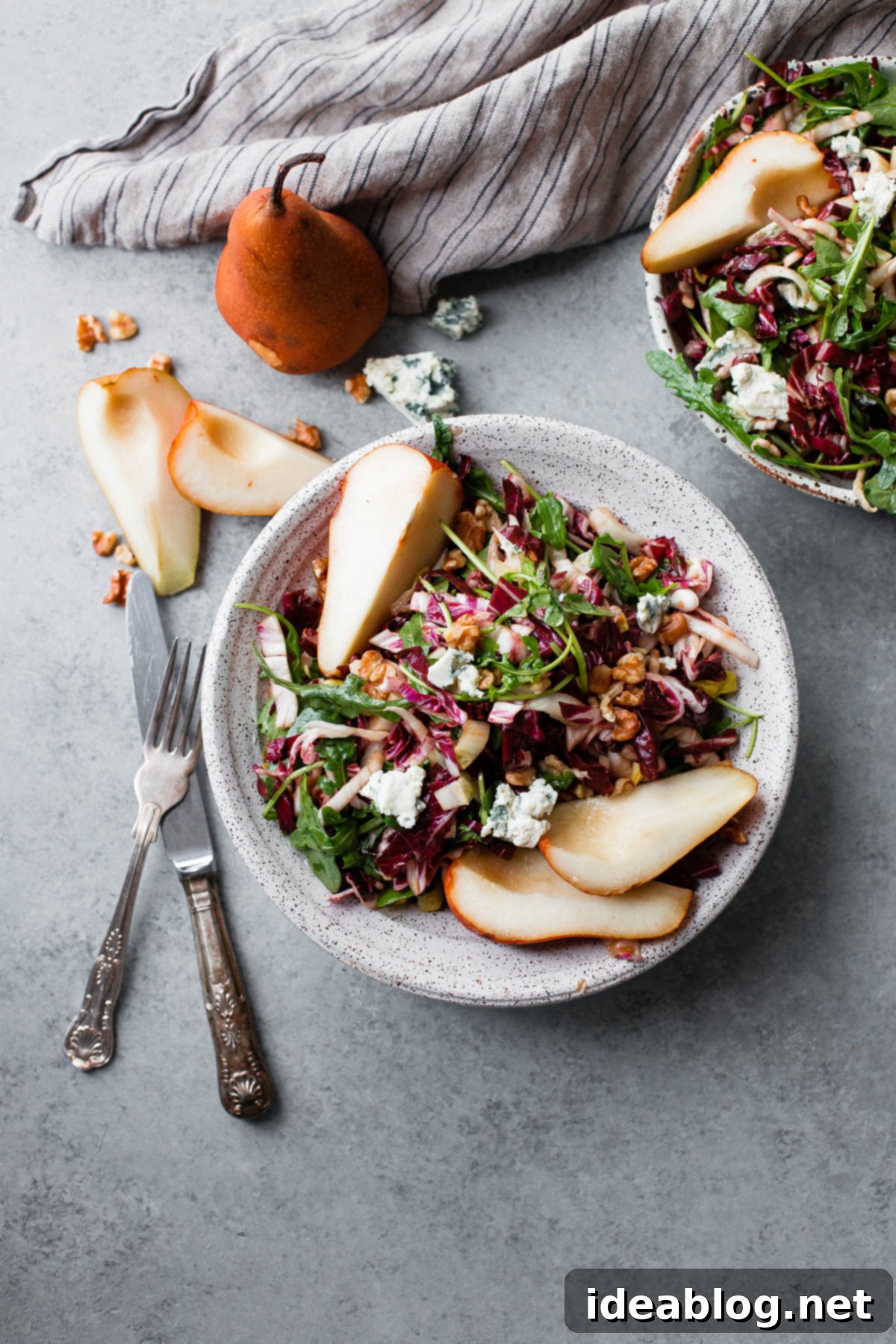Delicious Fall Harvest Salad with Maple Balsamic Vinaigrette: Your Ultimate Autumn Recipe

As the leaves begin to turn golden and a refreshing crispness fills the air, it’s a sure sign that autumn has arrived. Here in Chicago, the recent shift to cooler weather has me fully immersed in the joy of seasonal ingredients, and there’s no better way to celebrate than with this stunning Fall Harvest Salad. This vibrant salad isn’t just a feast for the eyes, bursting with an array of beautiful fall colors, but it’s also a symphony of flavors and textures. What’s more, it comes together in under 15 minutes, making it an ideal choice for a quick weeknight meal, a sophisticated lunch, or an impressive side dish for your Thanksgiving table.
Like all truly great salads, the magic of this Fall Harvest Salad lies in its exquisite balance. We aim to achieve harmony not just between varying textures – from the crispness of chicories to the creaminess of cheese and the crunch of nuts – but fundamentally, by hitting all four main elements of taste: sweet, salt, acid, and bitter. This fundamental principle guides me in all my recipe development, ensuring every bite is complex and satisfying. When these elements are thoughtfully combined, the result is a dish that’s far greater than the sum of its parts, leaving a lasting impression on your palate.
Why This Fall Harvest Salad Will Be Your New Autumn Favorite
This salad truly has it all, meticulously crafted to deliver a delightful culinary experience. Each component plays a vital role in creating a harmonious blend of tastes and sensations:
- Sweet Bosc Pear: Adds a natural, mellow sweetness and a delicate, juicy texture that beautifully contrasts with the greens. Its firm yet yielding flesh holds up well in the salad.
- Bitter Radicchio and Endive: These chicories provide a wonderfully bracing bitterness, which is essential for cutting through richer flavors and adding an intriguing depth.
- Toasted Walnuts: Offer a satisfying crunch and a rich, earthy flavor that complements the sweetness of the pear and the tang of the cheese. Toasting them amplifies their nutty aroma.
- Salty and Funky Gorgonzola Cheese: This Italian blue cheese delivers a pungent, creamy, and undeniably savory note. Its saltiness and distinct “funk” are key to balancing the bitterness of the greens.
- Peppery Arugula: Provides a fresh, slightly spicy kick, adding another layer of flavor and a tender counterpoint to the more robust chicories.
- Maple Balsamic Vinaigrette: A simple yet sophisticated dressing that ties everything together. The maple syrup introduces a warm, autumnal sweetness, while the balsamic vinegar provides a crucial acidic lift, and a hint of Dijon and garlic adds savory depth.
The best part about this salad is its incredible versatility. While the recipe below offers a perfect combination, you can easily make it your own by experimenting with substitutions or adding extra ingredients. For instance, if you’re looking to turn it into a more substantial meal, consider adding shredded roast chicken or turkey for a protein boost. This adaptability makes it a fantastic addition to any fall menu, from a light lunch to a hearty holiday side.

Embracing Chicories: The Stars of Bitter Flavors
One of the most distinctive and delightful elements of this Fall Harvest Salad is the inclusion of bitter radicchio and endive. These often-underestimated greens truly shine, bringing a sophisticated edge to the dish. It often feels like they don’t receive the widespread appreciation they deserve in the culinary world, but once you understand how to harness their unique qualities, they become indispensable.
Both radicchio and endive belong to the chicory family, a small but impactful subsection of the wider lettuce family. Chicories are renowned for their natural bitter compounds, which contribute to their robust flavor profile. This bitterness can vary depending on growing methods; for example, commercial endive is often cultivated without exposure to light, which keeps its leaves paler and less bitter than those grown in sunlight, which tend to become greener and more intensely flavored. This controlled cultivation helps ensure a palatable level of bitterness.
I personally adore the distinctive bitterness that both of these leafy greens impart to dishes, particularly in fresh salads. Their assertive flavor adds a much-needed counterpoint to sweeter or richer ingredients, preventing a salad from becoming one-note. Incorporating them into everyday salads throughout the week is a simple way to elevate your meals and introduce a new dimension of taste.
The Nutritional Benefits of Chicories
Beyond their unique flavor, radicchio and endive also pack a nutritional punch. They are low in calories but rich in vitamins and minerals, including Vitamin K, Vitamin C, and folate. Their bitter compounds, like intybin, are believed to aid digestion and liver function, making them not only delicious but also incredibly healthy additions to your diet. Integrating these vibrant greens into your diet is an excellent way to boost nutrient intake, particularly during the autumn season when fresh produce is abundant.

The Art of Balancing Bitterness in Culinary Creations
The secret to successfully working with bitter greens like radicchio and endive is to expertly balance them with other complementary flavors. In the kitchen, salty ingredients are our most effective allies in this endeavor. This is precisely why it’s a time-honored tradition to pair bitter greens with various salty components, such as cheeses, cured meats, or olives. These salty additions don’t just add their own flavor; they actually work to decrease our perception of bitterness, creating a more rounded and palatable taste experience.
In this particular Fall Harvest Salad, our primary balancing component is high-quality Gorgonzola cheese. This renowned Italian blue cheese, crafted from cow’s milk, is naturally salty and possesses a distinctive “funky” quality that makes it exceptionally compelling. Its creamy texture and bold flavor stand up beautifully to the assertive greens, creating a delightful interplay of tastes and textures in every mouthful.
Choosing the Right Gorgonzola
When selecting your Gorgonzola, remember that quality truly matters. The better the cheese, the more nuanced, complex, and satisfying its flavor will be. I implore you, if at all possible, to avoid the pre-crumbled varieties often found in supermarkets. These typically lack the depth, creaminess, and authentic flavor of a freshly crumbled wedge. Opt for a block of Gorgonzola and crumble it yourself just before serving; the difference is astounding. For salads, I particularly favor moderately creamy varieties of Gorgonzola, as they tend to meld beautifully with the vinaigrette, coating the greens in a delicate, flavorful embrace.
Other Bitter-Balancing Ingredients
While Gorgonzola is a perfect match here, the principles of balancing bitterness can be applied with other ingredients too. Sweet elements like roasted root vegetables (beets, sweet potatoes), dried fruits (cranberries, figs), or even candied nuts can temper bitterness. Acidic components, such as citrus juice or vinegars, also play a crucial role by brightening the overall flavor profile. Consider incorporating a mix of these to find your perfect balance in future bitter green salads.

Smart Preparation Tips for a Seamless Salad Experience
When assembling large salads, I always strive to streamline the process by minimizing extra bowls and steps wherever possible. This not only makes cleanup easier but also ensures efficiency in the kitchen. For this Fall Harvest Salad, you’ll find that preparing the vinaigrette directly in your main serving bowl is a fantastic time-saver. Simply whisk together the dressing ingredients in the bowl, and then add your greens and walnuts, tossing them right there. This method ensures maximum flavor coating with minimal fuss.
Another key tip for achieving optimal presentation and texture is to hold back certain ingredients until the very end. Instead of tossing the delicate pear slices and crumbled Gorgonzola directly with the greens, I prefer to reserve them and use them as a final garnish on individual plates. This keeps the pear from bruising and oxidizing, preserving its beautiful color and fresh texture. Similarly, the Gorgonzola retains its distinct shape and creaminess, adding a visually appealing element and allowing its flavor to shine through in each bite. Serving immediately after plating ensures the freshest possible experience.
For those eager to explore more seasonal delights, be sure to check out my other favorite fall salad recipes, offering a diverse array of creative and hearty options perfect for the autumn season and holiday entertaining.

Fall Harvest Salad
Pin
Review
SaveSaved!
Ingredients
For the Maple Balsamic Vinaigrette:
- 1 tablespoon aged balsamic vinegar
- 1 tablespoon fresh lemon juice
- 2 teaspoons pure maple syrup
- 1 teaspoon Dijon mustard
- 1 small garlic clove grated with a microplane
- 2 tablespoons walnut oil or extra virgin olive oil
- freshly ground black pepper to taste
- kosher salt to taste
For the Salad:
- 1 small head of radicchio (about 8 oz) quartered, core removed, and thinly sliced
- 2 endive heads ends trimmed, sliced lengthwise, and cut crosswise into slices
- 2 packed cups baby arugula
- ½ cup chopped toasted walnuts see recipe notes for toasting instructions
- 2 ripe, but slightly firm Bosc pears cored and cut into quarters or thin slices
- 4 ounces high-quality Gorgonzola cheese crumbled into small pieces from a block
Flavor Variations and Optional Add-Ins:
- shredded roast chicken or turkey for a heartier meal
- pomegranate arils for a burst of color and tart sweetness
- sliced apples (e.g., Honeycrisp, Fuji) as an alternative to pear or in addition
- roasted beets for earthy sweetness and vibrant color
- dried cranberries or figs for added chewiness and concentrated sweetness
Instructions
-
Prepare the Vinaigrette: In a large salad or mixing bowl (preferably your serving bowl), whisk together the balsamic vinegar, fresh lemon juice, pure maple syrup, Dijon mustard, and grated garlic until all ingredients are well combined and smooth. Slowly drizzle in the walnut oil (or extra virgin olive oil) while continuously whisking with your other hand. Continue whisking until the dressing is fully emulsified, creating a creamy and uniform texture. Taste the vinaigrette and season generously with freshly ground black pepper and kosher salt until the flavors are perfectly balanced.
-
Assemble the Salad: Add the thinly sliced radicchio, endive, baby arugula, and chopped toasted walnuts to the bowl containing the prepared vinaigrette. Gently toss all the ingredients together, ensuring that the greens and walnuts are evenly coated with the dressing. Avoid over-tossing to prevent bruising the delicate greens. Once mixed, divide the salad among individual serving plates. Top each salad serving generously with the reserved pear quarters (or slices) and crumbled Gorgonzola cheese. Serve immediately to enjoy the freshest flavors and textures.
Helpful Tips for Success:
- How to Perfectly Toast Walnuts: To bring out the best flavor and crunch in your walnuts, preheat an oven to 350ºF (176ºC). Spread the chopped nuts in a single, even layer on a baking sheet. Bake for 8 to 10 minutes, making sure to toss them halfway through to ensure even toasting. They are ready when they are lightly golden brown and emit a fragrant, nutty aroma. Keep a close eye on them as nuts can burn quickly!
- Managing Radicchio’s Bitterness: Radicchio is known for its distinctive bitter flavor, and the intensity can vary from one head to another. The maple balsamic vinaigrette, sweet Bosc pear, and salty, funky Gorgonzola cheese are all expertly chosen to help balance and temper this bitterness, creating a well-rounded flavor profile.
- Customizing for Your Palate: If you find you’re not particularly fond of strong bitter greens, or if a specific head of radicchio seems unusually bitter, I recommend adjusting the quantity. Try using only half a head of radicchio and supplementing the volume with other mixed greens or additional baby arugula. This allows you to still enjoy the unique texture and slight bitterness without it overwhelming your taste buds. You can also increase the amount of sweet or salty components slightly to further reduce the perceived bitterness.
- Make-Ahead Considerations: While best served fresh, you can prep some components in advance. The vinaigrette can be made up to 2-3 days ahead and stored in an airtight container in the refrigerator. Toast your walnuts a day or two before and store them at room temperature. Slice the pears just before serving to prevent browning. Combine the greens and dressing right before you’re ready to eat.
- Presentation Matters: To elevate your salad’s visual appeal, arrange the pear slices and Gorgonzola artistically on top of the tossed greens. A light sprinkle of fresh herbs like chives or parsley can add a final touch of color and freshness.


